ALL ABOUT BREASTFEEDING
HOW to MAKE BREASTFEEDING
an ENJOYABLE JOURNEY for BABY and MOM

Breastfeeding it's unfortunately a very sensitive topic for many new mothers that are trying to find their balance between doing what's best for their little one while facing the reality of dealing with many common struggles, (such as low milk supply, post natal depression etc..) and trying to live up to society expectations at the same time.
I often come across lovely Neo mothers tormented by a sense of guilt they developed by following the unrealistic standards our overly opinionated culture has set throughout the years, ruining what should be one of the most magical and precious time in their lives.
So let me help you clarify few misconceptions that could impact your approach to breastfeeding in a more positive way.
While it is true to say that breast milk it's possibly the best food your baby can have during those first months of life, there are way too many variants to keep in consideration for me to say that this apply in each scenario.
Yes, breastmilk have natural antibodies in it that can help boost your baby's immunity system but breastfeeding is not necessarily always the best option for every baby and in some cases it could be more harmful than beneficial.
Let's start by debunking one of the biggest myths in this topic: breastfeeding is NOT "the easiest and most natural thing in the world" has many people try to make you believe.
As someone that have been in the business for many decades helping hundreds of women as a lactation and breastfeeding consultant, you'll be surprise to know that in actuality over 80% of women struggle with the whole breastfeeding process, making it not as enjoyable as they were expecting but a rather frustrating and quite exhausting duty. Very rarely I've encounter a mother effectively breastfeeding her baby without any issue...A bit of a unicorn if I may say!
Your newborn just arrived into this world, and as you need support from doulas or midwives to help you learn how to properly breastfeed your infant, your baby need time to learn as well.
Newborns have never nursed on a breast prior their arrival into this world and although they have reflexes, (such as routing), to guide them through the feeding process, they are learning day by day just as you are.
The fact that a female body can produce milk straight after delivery doesn't automatically make women breastfeeding experts!
It's a bit like expecting women to deliver their own babies without the help of an Obstetrician-Gynaecologist doctor, just because "nature" gave them the power to reproduce..I hope you understand the absurdity of this logic.
That's why there are many professionals that can help you through this journey, such as lactation consultants.
So please be very cautious in asking too many opinions around you, especially if they come from unqualified people that know just as much as you do.
As lucky as we are to live in a technological era where knowledge it's just one click away, this also imply easy access to many wrong informations.
So as I always say be very cautious in where you source your informations as today we are overly saturated with many conflicting opinions which only end up creating more confusion than clarification and to quote one of my favourite saying: "false knowledge is far more dangerous than ignorance".
Always educate yourself from reliable sources that have tangible training or medical background.
Saying that, let me give you few example in when breastfeeding instead wouldn't be the best option:
1-LOW MILK SUPPLY: more common than you may think. Not all women are blessed with high milk supply and so in this case supplementing your baby's diet with a little bit of formula is the best way to go. Your priority must always be to feed your baby well enough for him to develop.
We live in a time where there are many excellent formula brands to choose between that follow very strict FDA regulations.
Just 30 years ago we didn't have all this options.
So if you are experiencing low milk supply don't feel guilty about it, it's not your fault and remember that majority of women are in the exact same position.
Although you may be able to gradually increase your milk supply by following a healthier diet, taking supplements and pumping regularly, it takes time for you to see improvements and results are not guaranteed. That's when increasing your baby's feeding sessions with some formula top ups is the best solution.
Just please don't be one of those mothers that stubbornly stick to exclusive breastfeeding although their supply is undoubtedly insufficient to satisfy their baby's appetite. I saw women way too often holding on to breastfeeding in an unhealthy way because pressured by society standards, even when it was clearly not enough to support their baby's hunger. If you follow this path you will find yourself stock in a never-ending cycle of constant latching where your baby seem to be always hungry because not able to receive the full meals he needs in order to grow.
First of all there is active latching and comfort latching and most mothers don't know the massive difference between the two.
With active latching your baby is actually eating while with comfort latching your baby is just using your nipple as a pacifier.
Having your baby snoozing on your breast for hours with your tit in his mouth doesn't mean he is actually feeding and unfortunately this is the number one mistake I constantly see happening.
Active latching is when you can undoubtedly hear your baby swallowing milk, while comfort latching is when your baby is just using your breast as a soother until he falls asleep.
You can see how this pattern if not corrected early on can lead to bad feeding habits that will be harder and harder to break as time pass by.
In the scenario of low milk supply babies tend to fall asleep on the breast quite quickly, as it takes a tremendous amount of energy for them to suck out small quantities of milk. This inevitably will create the wrong association, teaching your baby to use breastfeeding for "cuddles"rather than for eating and turning what started as a feeding session into a nap.
You can see how this can quickly become an unhealthy pattern and using formula as a top up would be your best solution.
2-MASTITIS: Mastitis it's a common infection of the breast tissue caused by clogged milk ducts. Sore cracked nipples and redness are the most common symptoms which in some cases may lead to light bleeding or pus formation. Women experiencing Mastitis should temporarily stop breastfeeding and give themselves time to heal. Also it's very important to avoid the transmission of pus or blood into your baby's mouth. Frequent pumping it's strongly recommended as emptying your breasts will avoid further duct blockage. Also your doctor may prescribe you some antibiotics making breastfeeding not an ideal choice for that time. Pumping and dumping while taking medications it's usually recommended, (depending on the case), but always consult your doctor.
As you can imagine formula feeding would be your best option in this scenario until your breast is healed.
3-MEDICATIONS: Women that have specific medical conditions which require the intake of heavy medications shouldn't breastfeed. The same apply for women who are undergoing radiation therapies.
4-MILK INTOLERANT BABIES: some babies are unable to digest breast milk as their body is not able to break down sugar galactose. In this case a special lactose free formula will be prescribed from your doctor.
5-TONGUE TIE: Tongue tie it's a fairly common oral condition caused by a small piece of tissue, (called frenulum), that restrict the tongue's range of motions affecting your baby's latching performance.
In the majority of cases babies with tongue tie get quite frustrated on the breast as they seem to struggle with the basic sucking and swallowing motions. They also tend to intake more air while feeding making them more colicky than normal.
It's generally quite easy to fix the condition that involves the simple snapping of the frenulum area solving your baby's latching issues almost instantly.
However, there are different levels of tongue-tie and you may need to see a specialist.
6-DIARRHOEA and ACID REFLUX: common side effects among exclusive breast fed babies. One of the biggest challenges for breastfeeding Moms is the constant monitoring and restrictions of their diet. Obviously, everything you eat goes into your milk and so into your baby. That's why when choosing to breastfeed you should avoid caffeine, alcohol, spicy food, dairy, citrus, beans, broccoli, cauliflower, etc...
This is not an easy task and as you can imagine it's quite hard to pinpoint what may have caused your baby's stomach to feel upset should that occur.
With babies experiencing chronic diarrhea or acidity, the introduction of some formula into their diet can often improve their condition as formula tend to thicken their stool and help digestion.
It's also a good chance for mothers to take a break from dietary restrictions should you feel particularly frustrated.
There is nothing wrong with an occasional glass of wine to help you ease up a particularly tough day, just pump and dump as per recommendation or check your milk with test strips, a great new way to test the alcohol level in your milk.
Now that we've understood the huge difference between active feeding and comfort sucking let's go through some of the most common latching positions:
1-THE CRADLE HOLD: the most popular one. Rise your baby to your breast height by using a nursing pillow. Although this is one of the most comfortable positions used by most. mothers, it is not recommended when dealing with a very sleepy baby as the "cuddling position" your infant find himself into together with Mom's body's warmth will only decrease his chances to stay awake and have an active feed.
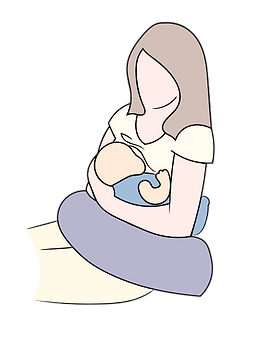
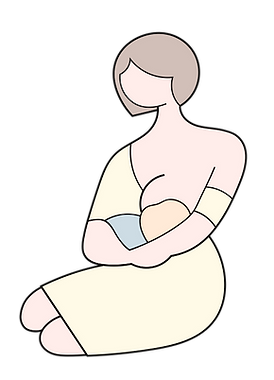
2- THE FOOTBALL HOLD: One of my absolute favourite position and particularly loved by mothers that had a C section since in this position the baby's body weight is not laying on your stomach but alongside your body. Support your baby's head with your hand while tucking his feet and legs under your arm. Use a pillow to raise your baby's body to your breast level. Great position especially when feeding twins.
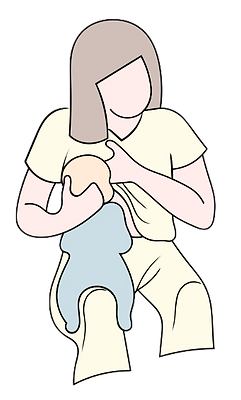
3-AUSTRALIAN HOLD: in this position, the baby is vertically held facing you while straddling your thigh. His bottom is supported by your knee while your hand hold his head close to your breast during latching. This is an excellent position great to keep your baby wide awake and active on the breast. It is not well known by many and quite underrated.
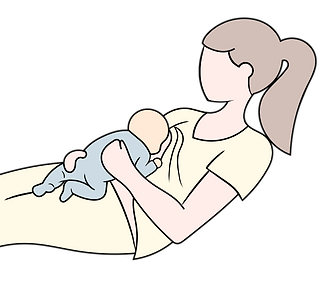
4- BACK LYING: as the name suggests in this position you are comfortably lying on your back on a 45 angle degree, (not completely flat), it usually works best on the couch and by using pillows that will help you achieve the perfect posture. Place your baby tummy down on your chest, (as if he was doing tummy time on your body), bring your nipple close to his mouth and let him latch. This is a very safe position as your body it's completely supporting your baby without the need to hold him too tight as in other positions. Also, the position itself make it much easier for babies to stay awake while eating.
5-THE SIDE LYING HOLD: this position allows you to comfortably lie down on your bed while nursing your baby. As comfortable as it sounds I am personally not a big fan of it for two main reasons:
1-SAFETY..if you feel particularly tired I strongly discourage you from using this position as you might easily fall asleep and accidentally roll over your infant. The risk of SIDS when co sleeping with your baby is much greater.
2-ACTIVE FEEDING..we've already touched base on the importance of keeping your baby awake and active during his feeding session, ( if you don't want to to end up feeding every 2 hours), and you can imagine how easy it would be for a sleepy baby to pass out in such cozy position. Also, I am a big believer of instaling the right associations since early days, and feeding your baby in a sleeping position is not ideal. This position can also be inverted where your baby is still facing your breast but in an upside-down position.

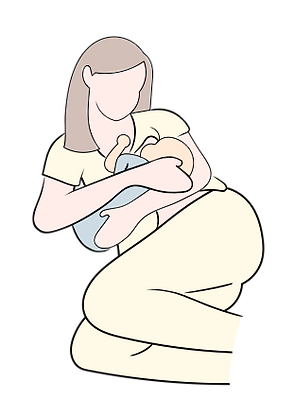
6- SIDE LYING CRADLE: This position it's an hybrid between the SIDE LYING HOLD and the CRADLE HOLD. Mom is lying on her side at a 45 degree angle, (not completely flat), while feeding her baby in a cradle position.This technique is more effective after few weeks from birth, when both you and your baby are more experienced breastfeeders.
LATCHING: The way how your baby latch will determine how successful his feeding session will be.
A good technique to properly latch your baby is by teasing his upper lip with your nipple until he route and open his mouth wide enough for him to cover the whole areola on your breast. A good latch not only will grant an effective feed, but promote high milk flow maximising your supply production.
On the contrary if your baby is not well latched he will most likely get frustrated on the breast intaking air and eating smaller quantities. If you think your baby didn't latch well, you can gently unlatch him and try again. Also sometimes switching side can be a solution if your baby seem particularly unsettled.
BURPING: burping your baby often not only promote his digestion reducing chances for possessing but it help you keep your baby awake and active on the breast as the sense of fullness that trap air create into is little stomach lead to sleepiness.
You may notice in fact that your baby usually slow down his sucking motion every time he is ready to burp.
TO UNLATCH YOUR BABY: some times your baby will come off the breast on his own, other times you may wish to break the suction and unlatch your baby for a burp, a diaper change or to wake him up.
The proper way to unlatch your infant without damaging your nipples is by gently inserting a clean finger into the corner of your baby's mouth to create a pocket that will allow you to gradually remove your breast from his mouth.
Remember each baby is different and has different preferences. The key to a joyful breastfeeding journey is to keep trying different positions and tecniqques until you find what best works for you!